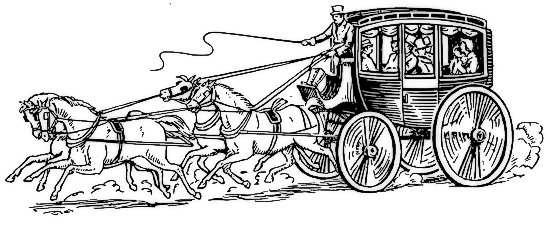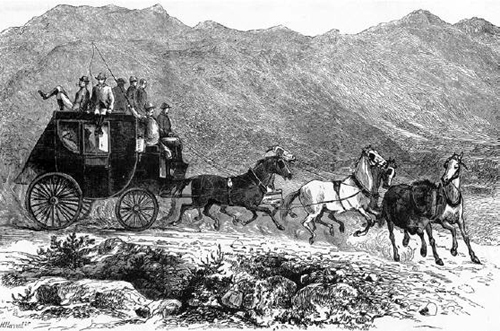Picture it! Its 1860 and you have to get from Kansas to California and all you have is the ability to use your two legs to walk or another form of transportation. A technological marvel that allows you to go over 1000 miles over the course of three to four weeks.
You would take a stagecoach of course. This form of transportation was developed in 1827 and consists of a wagon on four wheels pulled by four to six horses, depending on the size of the stagecoach its self. In general, each coach would weigh more than 2000 pounds so they definitely need a lot of horsepower to pull that across country.
The phrase Stagecoach implies that the journey occurs in “stages”. There were two types of station stops along the way, the Swing Station and the Home Station. The Home Stations were the actual homes of citizens living along the route. The passengers and driver would enter this person’s home and there would be food and a place to sleep over night before you continuing to the next location. The Swing Station was basically a stop to change the horses. The horses tired quickly so there were stations that not only exchanged the horses but there were blacksmiths there as well to fit their shoes and groom them before they started another journey.
The invention and use of the Stagecoach became a huge industry during this time period. The development of this industry economically boosted the many different components of the stagecoach industry and provided jobs for the builders of the coach, the drivers of the coach, horse providers (including the breeders, trainers, and blacksmiths) and the homeowners at each Home Station. Also, telegraph operators were available at a lot of the Swing Stations as well. All of these people drove this innovate industry that helped make the world, or in this case the US, a much smaller place.
Even though this new way of travel was very useful it did come with many dangers. The coaches weren’t always as sturdy after passing through rough terrain. Also, intense weather events caused casualties and major damage to the coaches. And lastly attacks from thieves would also put its passengers in peril. There was also an issue of comfort involved with traveling via Stagecoach. Passengers often had to sleep sitting up, the seats were rather hard, and there was no food service on the coach. Also, there were issues with the “run away horse” phenomenon that would result in an extremely rough ride or sometimes the capsizing of the entire vessel.
Abbot Downing Company was the leading manufacturer of Stagecoaches and created over 40 carriages over the course of their business. Their most popular design was a strap braced underneath the carriage giving a swing motion instead of the spring suspension motion, which was more uncomfortable for passengers. The Concord Stagecoaches model was another part of the Abbot Downing Company. The Concord was considered to be more sturdy and the most comfortable in comparison to other models. Stagecoaches from this company could cost anywhere from $1200 – $1800 per coach.
This Stagecoach also came with a storage compartment that was called the Leather Boot that housed luggage and sometimes the mail. The rest of the luggage was stored at the top of the carriage. This also served as another seating area for passengers that could not find a seat below.
Before the end of Stagecoach era there were over 150 stations between Kansas and California. But the demise of the stagecoach industry came in 1869 when the railroad expanded. The journeys proved to be too rough and the horses suffered quite a bit in pulling such heavy loads. Trains were a much easier and safer way to travel and it was also a faster way to move about which shifted the entire idea of travel in the United States.



